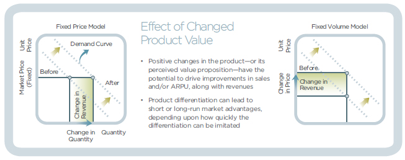Promotional discounts, credits or value-add offers can be an important part of a product launch strategy. A properly timed discount, upsell or cross-sell or “bundling” can positively change the perceived product value and dramatically impact adoption of SaaS applications.
But, making on-the-fly changes according to the dynamic needs and circumstances of customers can inherently complicate your billing and pricing models. How does your billing system support the various iterations of a subscription discount, promotion or credit?
For example, how does the discount get applied? What is the duration of the discount? Does the discount apply to all subscription types (recurring, one time charges, activity)? What about conflicting offers? What types of customers are eligible for discounts?
Subscription discounting can get complex very quickly because most billing platforms use a very limited set of “price levers” (time, duration, quantity) capable of shifting the Perceived Product Value.
What you want is to have many price levers around where you dynamically configure and reconfigure services and pricing on the fly: subscriptions + sign-up/activity/event fees + bundles + add-ons + incentives + promotional products.
The ability to add and manage activities, consumption or usage-based price levers to a promotion gives a company a powerful tool for growing its customer base (recurring revenue) and maximizing lifetime value of the customer (reduce churn).
Effect of Changed Product Value
Positive changes in the product – or its perceived value proposition – have the potential to drive improvements in ARPU. Product differentiation can lead to short or long-term market advantages, depending upon how quickly the differentiation can be continued.
As stated earlier, with the simplest subscriptions, a business only has control over the price, the term of the offering, and the product mix of the relationship. Because choice is limited, tweaking price levers in those three categories provides limited results.
For example, if a $10 per month subscription is the MSRP, reducing the price to $7 to attract more users may simply cannibalize the existing customer base.
For this reason, it is important to add additional pricing levers around consumption or usage parameters to evolve the relationship with the customer. For example, the consumption or usage price lever can be implemented as a limit or as a set of charges that are generated by ongoing use. For example, as a person consumes, reward him with a discount or promotion every time he reaches a certain threshold, thus enticing him to continue to consume (along the lines of airline “point” systems.
When charging for different classifications of the good or service, customers paying the set amount for unlimited access will have a different value equation than those paying a lower price for limited access.
Over time, customers can migrate from an unlimited ($10 per month) to other price segments, depending on the customer experience or the changing perception about a subscription’s value – especially to those initially not interested.
Customers that do not see value in paying a set amount for unlimited access to a good or service may become interested if offered a chance to pay a nominal per piece price. For those subscribers, the value comes in the flexibility to consume the good or service at will. In a SaaS application, for those not willing to pay for a $10/month for unlimited access to articles may be willing to pay a $7/month plus a discounted price of $0.25 per activity such as time entry, project, download, computing cycle, contact, or any other measureable activity.
In this scenario, the customer who does not see value in paying $10 for unlimited access may become interested when he can pay $0.25 for only the activities that have value. At $0.25 per activity, the customer has a low barrier to trying out the new content, and the business succeeds in making money on content that previously would not be monetized. But the real value for the business is the opportunity to convert the customer to different subscriptions over time, as the subscriber’s situation and interests evolve.
Billing: A Strategic Asset & Enabler of Innovative, Sustainable Business Models
In a subscription business model, it is the relationship with a person that matters most, and no customer touch point is more important than billing, as it connects businesses with customers on an ongoing, personal basis.
Though not the sexiest topic, “billing” is the medium by which companies can truly drive and capitalize on customer usage patterns and preferences.
Billing is, therefore, central to improving adoption. Product management and sales strategies that focus on long-term relationships and maximizing customer lifetime value must address billing models.
Utilizing any one of those practices requires sophisticated billing that goes beyond a cookie-cutter approach for maximizing volume and per-unit profits. Now, billing has to boast real-time intelligence, the type of which is derived only from sophisticated rating and charging engines built to dig into data about actual usage (as opposed to forcing business people to pore over enormous reports after the fact, when opportunities have slipped away).
The next generation of billing has to enable business users to dynamically implement, enforce and change parameters on the fly. By implementing activity, usage or consumption-based billing, companies create more opportunities to innovate and drive new sources of revenue.
About the Author
 Christopher Couch is COO and co-founder of Transverse, LLC. TRACT, from Transverse LCC, is the all-in-one activity, rating and subscription-billing platform that can bill for anything. SaaS, cloud, MSP, ISVs, telcos or wireless providers with TRACT’s pricing levers to rapidly build and evolve any business model: if it can be metered or measured, TRACT can bill for it. Learn more at www.tractbilling.com
Christopher Couch is COO and co-founder of Transverse, LLC. TRACT, from Transverse LCC, is the all-in-one activity, rating and subscription-billing platform that can bill for anything. SaaS, cloud, MSP, ISVs, telcos or wireless providers with TRACT’s pricing levers to rapidly build and evolve any business model: if it can be metered or measured, TRACT can bill for it. Learn more at www.tractbilling.com

